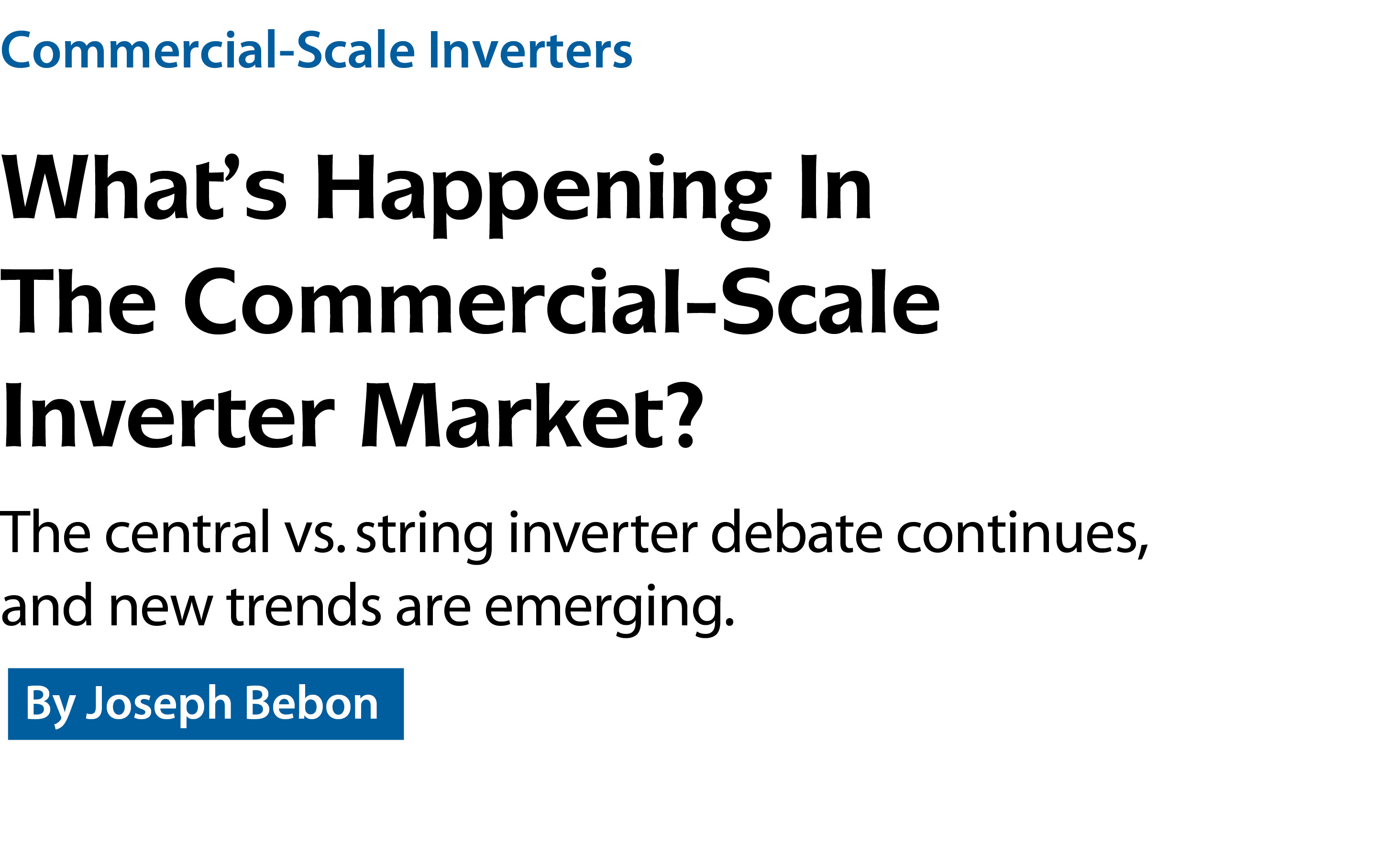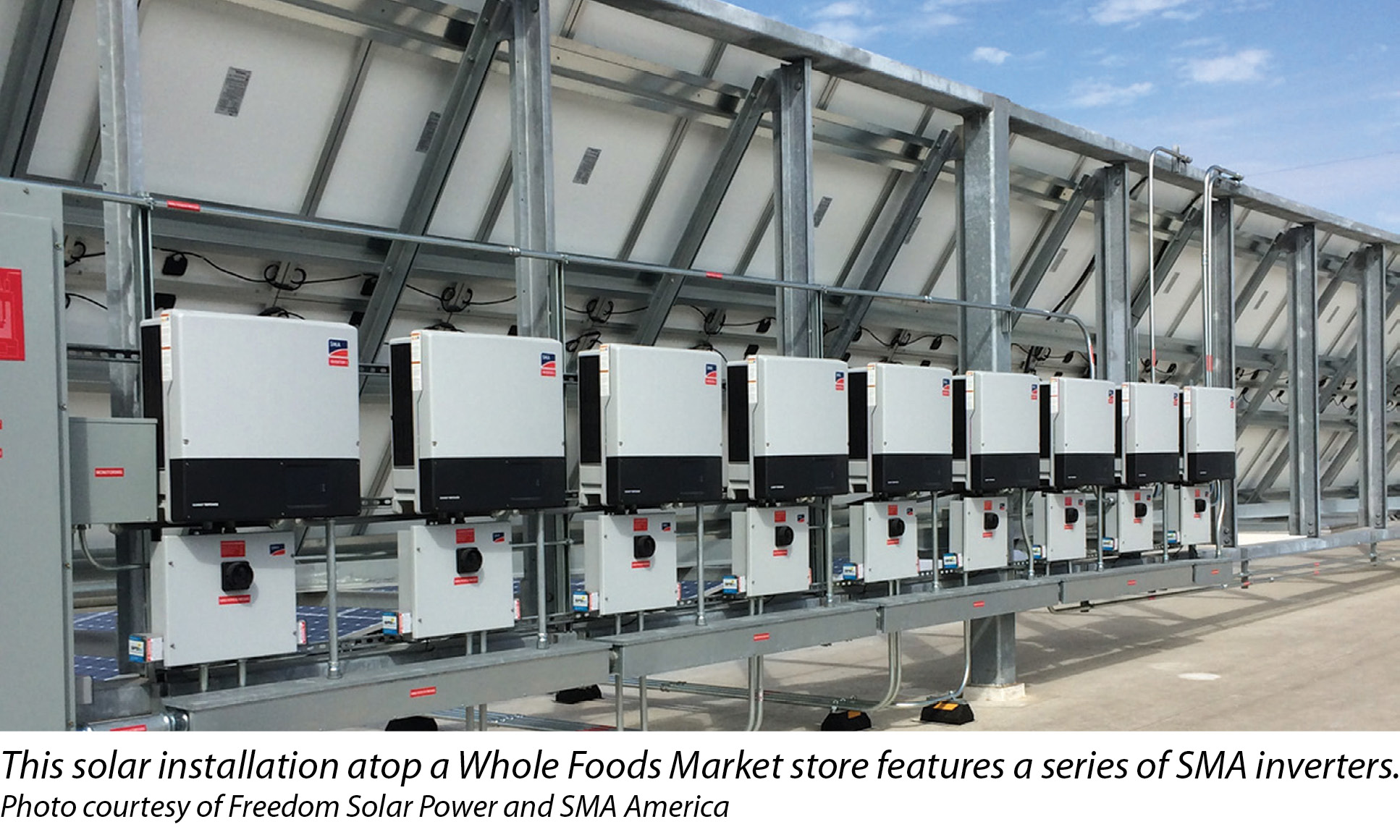

301 Moved Permanently
As the U.S. commercial and industrial (C&I) sector continues to adopt solar power, PV developers and integrators serving that market are turning to more advanced inverter technology. In fact, a lot has changed in the past few years.
Several manufacturers have offered insight into the commercial-scale inverter market and identified emerging trends. For example, nearly all of the companies, if not all, suggest solar developers are increasingly choosing string inverters over central inverters for commercial installations.
“Five years ago, the use of central inverters was the accepted practice. Now, you’re seeing the proliferation of decentralized project designs using multiple, larger-power string inverters,” says Sarah Ozga, a central inverter product manager at ABB.
Ozga claims Power-One, which ABB acquired in 2013, helped foster the trend toward decentralized systems with the TRIO 20.0/27.6 kW, 1,000 V, three-phase string inverter.
“Now, many manufacturers in the solar space have a 1,000 V, three-phase string inverter,” she says. “Interestingly, some of the larger central inverter manufacturers that played a prominent role in this space are no longer around, partly due to this shift.”

Chinedu Igbokwe, global product manager for Solectria, goes so far as to say, “PV developers and integrators almost only use 1,000 V PV arrays with string inverters. Five years ago, we saw 600 V PV arrays with central inverters.”
“There has been an increased adoption of three-phase string inverters for ever-larger commercial-scale PV systems, which is a trend that we expect will continue,” states Brad Dore, director of marketing for SMA America. “Three-phase string inverters are suitable for almost any module configuration and can be scaled up or down in a cost-effective manner to match power demand.”
Furthermore, he notes three-phase string inverters are a major component of a decentralized PV system design, which is growing ever popular.
“Benefits of decentralized PV design include simplified service that requires less specialized expertise, improved logistics, increased energy production and improved accessibility to difficult sites,” explains Dore. “The redundancy provided by multiple inverters preserves system uptime, protecting against lost profits.”
So, are central inverters going the way of the dodo in commercial applications? Andrew Kinross, director at consultancy Navigant’s energy practice, says not quite.
According to him, both central inverters and module-level power electronics (MLPE), including micro-inverters and power optimizers, still make up a portion of the commercial market, on both the high and low size ranges, respectively.
“In order for there to be a shift from central inverter to string inverters for commercial applications, you need to, relatively speaking, lower the cost per watt, improve efficiency, lower the operations and maintenance (O&M) cost, improve uptime, and improve power output. In addition, you need to comply with regulations,” says Kinross.
Lower $/W cost, improve efficiency. Kinross says he believes string inverters have closed the gap on these metrics with central inverters. “This has occurred mainly through scale economies and an increased level of investment on the part of the string inverter companies,” he explains. “Also, some regulations, such as disconnect requirements, make it less costly on a [balance-of-system (BOS)] basis for string inverters than central inverters.”
Lower O&M cost, higher uptime. “You don’t need to repair a string inverter,” he says. “Instead, you simply remove the unit and replace it with another one, which a technician typically carries in their truck. The defective product can be sent back to the manufacturer for exchange. As a result, you don’t need spare inverter parts.
“By contrast,” he continues, “central inverters normally need a technician from the manufacturer to fix the problem on-site, which might take longer. Or, you need an on-site technician who is skilled in fixing the inverter and must carry a spare-parts inventory.
“In addition, operators get more granular data from string inverters versus central inverters and can pinpoint issues more quickly.”
Improved power output. Kinross says string inverters achieve a higher output, especially where there are differences in shading and module orientation. “This normally occurs on roof systems and less so on ground-mount systems (especially those in wide-open flat fields with no shading),” he explains.
Comply with regulations. Kinross notes both string and central inverters are being designed to comply with California’s Rule 21, which has to do with two-way communication and other requirements. There are three phases to this rule - the first of which is being rolled out this year, he adds.
“It’s likely that central inverters will become more of a niche player in commercial applications, but they won’t go away completely,” says Kinross. “There will still be certain applications, namely the large ground-mount applications with flat fields or large rooftop applications with flat rooftops.
“Of course,” he stresses, “central inverters will continue to have the majority of the market share of utility-scale projects owing to their economies of scale.”
Cormac Gilligan, solar supply chain senior analyst for IHS Technology, notes commercial-scale inverter choices vary from project to project and among solar engineering, procurement and construction contractors - which is why “the majority of leading PV inverter suppliers offer a broad portfolio in order to be flexible to customer needs.”
Other trends
John Merritt, director of applications engineering for Ideal Power, says his company is seeing growing demand for integrated solar PV and energy storage solutions from the commercial sector.
“These systems offer higher efficiencies and deliver a broader set of value streams to both end-user and utilities when compared to stand-alone PV and energy storage,” says Merritt, adding that an integrated solution can help support critical power sources during grid outages. “Grid resiliency is a key value stream.”
In late 2014, Ideal Power launched its Grid Resilient family of power conversion systems based on its patented Power Packet Switching Architecture. Merritt says these second-generation products are available in 125 kW and 30 kW sizes, as well as in dual- and multi-port configurations.
“Energy storage is growing fast, but the project economics still need to be improved,” says Kinross. However, he adds that there has been a lot of investment in the technology and that some solar developers and energy storage companies have teamed up.
For example, REC Solar recently entered a partnership with Green Charge Networks under which REC Solar will market energy storage systems with its solar projects.
“Energy storage adds to the list of compelling reasons why businesses should go solar,” said Al Bucknam, CEO of REC Solar, in the December announcement. “Commercial customers save money by adding energy storage to reduce their peak demand, which can account for up to 50 percent of their electricity bill.”
Meanwhile, Dore says SMA America is seeing demand for advanced inverter capabilities, such as grid management functions, now more than ever.
“These features ensure that the inverters can operate in any market and meet even the strictest regulatory requirements and emerging interconnection standards, such as the recent revisions to California’s Rule 21 and HECO’s transient over-voltage and ride-through requirements,” says Dore.
He notes such functions are integrated into SMA’s recently released Sunny Tripower three-phase inverters: the Sunny Tripower 30000TL-US and the Sunny Tripower 60-US.
Solectria’s Igbokwe says some commercial-scale developers are requesting a complete PV system package: “We are seeing customers wanting us to provide not only inverters, but also other BOS components like medium-voltage transformers, switchboards and inverter-mounting components.”
Igbokwe adds there has also been demand for wireless networking in order to eliminate the cost of installing wired communication lines in a PV array.
ABB’s Ozga says two emerging trends - the use of larger power string inverters and the growing interest in tilt mounting - “contributed greatly” to the design of the company’s new TRIO 50.0 kW inverter.
Regarding the larger power string inverters, she says, “Customers want to install fewer inverters while still utilizing a decentralized design.” As for the latter emerging trend, she continues, tilt mounting helps developers place an inverter next to the array on a roof and “comply with the recent evolving rapid shutdown codes across the U.S.”
Finally, Navigant’s Kinross says MLPE have crept into the low-power commercial solar segment: “These have taken the residential market by storm and have taken some market share for small commercial.”
Looking ahead
According to IHS’ Gilligan, the average size of three-phase string inverters is forecast to increase this year.
“For example, in 2013, the average size of three-phase low-power (≤99 kW) inverters was 15 kW, but in 2016, this is forecast to increase to 25 kW as larger power ratings, such as 40 kW and 50 kW, are shipped,” he explains. “By the end of 2016, IHS predicts that more 80 kW and 100 kW three-phase string inverters will be released by leading PV inverter suppliers.”
Kinross offers some predictions from Navigant regarding the U.S. C&I solar inverter market.
Navigant says that sector installed 1.45 GW of inverters in 2015 - representing an inverter market size of $217 million at an average sales price (ASP) of $0.19/W DC. The company expects the installation number to rise this year to 2.1 GW, totaling a market size of $369 million at a slightly lower ASP of $0.18/W DC. Ultimately, Navigant forecasts even more improvement across the board by 2020, with installations reaching 3.7 GW, the market size totaling $539 million, and the ASP dropping to $0.15/W DC.
Commercial-Scale Inverters
What’s Happening In The Commercial-Scale Inverter Market?
By Joseph Bebon
The central vs. string inverter debate continues, and new trends are emerging.
si body si body i si body bi si body b
si depbio
- si bullets
si sh
si subhead
pullquote
si first graph
si sh no rule
si last graph